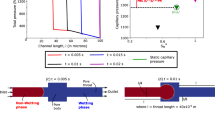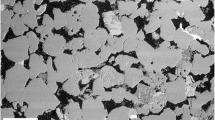Abstract
Generally, an empirical relationship between capillary pressure and saturation obtained by means of laboratory experiments is used to describe capillary pressure. However, this relationship assumes equilibrium in the distribution of the phases in the porous medium. This assumption is valid in cases where saturation varies slowly, however it may not be appropriate for application in faster processes. In such cases, dynamic effects may have an influence on the system. In this study, an extended relationship of capillary pressure that includes the dynamic effect is chosen to be implemented into the percolation model of two-phase flow in ultra-low permeability (K is less than 1 × 10−3 μm2) sandstones. This model is used for the numerical simulation. The purpose of this study is to examine the influence of the inclusion of the extended relationship on two-phase flow. Firstly, the dynamic effect was investigated through laboratory tests and then the factors influencing on the dynamic capillary pressure were analyzed. Secondly, the percolation model of two-phase flow considering the dynamic effect was established. Finally, the influences of dynamic capillary pressure on two-phase flow were investigated. The results reveal that the dynamic effect of capillary pressure is obvious in ultra-low permeability reservoir. The inclusion of the dynamic capillary pressure relationship has a different influence compared to the cases without capillary pressure. The existence of dynamic effect has a significant influence on the water saturation distribution and oil production. The moisture content rises faster for water-wetting sandstones but the rising velocity is reduced for oil-wetting sandstones considering the dynamic effect.











Similar content being viewed by others
Abbreviations
- α s :
-
Empirical constant, which is equal to 0.1
- φ :
-
Porosity (%)
- μ w :
-
Viscosity of the wetting phase (mPa s)
- P e and λ :
-
Factors of capillary pressure–saturation relationships in the Brook–Corey model
- τ s or τ :
-
The coefficients of dynamic capillary pressure (kg m−1 s−1)
- P ec :
-
The static capillary pressure (MPa)
- P dc :
-
The dynamic capillary pressure (MPa)
- P w :
-
The capillary pressure of wetting phase (MPa)
- P o :
-
The capillary pressure of non-wetting phase (MPa)
- K :
-
Absolute permeability (10−3 μm2)
- K w :
-
Absolute permeability of wetting phase (10−3 μm2)
- ρ w :
-
Density of the wetting phase (kg/m3)
- g :
-
Gravity acceleration (m/s2)
- L :
-
Characteristic length (cm)
- D :
-
Diameter (cm)
- q w :
-
Injection velocity of water phase (ml/min)
- S oi :
-
Initial oil saturation (%)
- S or :
-
Residual oil saturation (%)
- S wc :
-
Connate water saturation (%)
- K rw (S or):
-
Relative permeability to water under residual oil saturation (dimensionless)
- K ro (S wc):
-
Relative permeability to oil under connate water saturation (dimensionless)
- K ro :
-
Relative permeability to oil (dimensionless)
- K rw :
-
Relative permeability to water (dimensionless)
- u w :
-
Flow velocity of the wetting phase (cm/s)
- u z :
-
Injection velocity of the wetting phase at the inlet end of core (cm/s)
- K air :
-
Absolute permeability to air (10−3 μm2)
- K wat :
-
Absolute permeability to water (10−3 μm2)
- EOR :
-
Oil recovery (%)
- S we :
-
Water saturation at the core outlet (%)
- S wi :
-
Initial water saturation (%)
- f o :
-
Oil ratio at the core outlet (%)
- f w :
-
Water ratio at the core outlet (%)
- I :
-
Injection ability at some time/the initial injection ability
- \( \bar{V}_{o} \,(t) \) :
-
Dimensionless cumulative oil production volume
- \( \bar{V}_{(t)} \) :
-
Dimensionless liquid production volume
- V f :
-
The volume of core sample (cm3)
- S Hg :
-
The mercury saturation (%)
- V Hg :
-
The volume of injected mercury (ml)
References
Biggar JW, Taylor SA (1960) Some aspects of the kinetics of moisture flow into unsaturated soils. Soil Sci Soc Am J 24(2):81–85
Brooks RH, Corey AT (1964) Hydraulic properties of porous media. Hydrology Papers, Colorado State University, Fort Collins
Das DB, Gauldie R, Mirzaei M (2007) Dynamic effects for two-phase flow in porous media: fluid property effects. AIChE J 53(10):2505–2520
Das DB, Mirzaei M (2012) Dynamic effects in capillary pressure relationships for two-phase flow in porous media: experiments and numerical analyses. AIChE J 58(12):3891–3903
Das DB, Mirzaei M (2013) Experimental measurement of dynamic effect in capillary pressure relationship for two-phase flow in weakly layered porous media. AIChE J 59(5):1723–1734
Elzeftawy A, Mansell RS (1975) Hydraulic conductivity calculations for unsaturated steady-state and transient-state flow in sand. Soil Sci Soc Am J 39(4):599–603
Hanspal N, Das DB (2012) Dynamic effects on capillary pressure–saturation relationships for two-phase porous flow: implications of temperature. AIChE J 58(6):1951–1965
Hanspal NS, Allison BA, Deka L, Das DB (2013) Artificial neural network (ANN) modeling of dynamic effects on two-phase flow in homogenous porous media. J Hydroinform 15(2):540–554
Hassanizadeh SM, Gray WG (1990) Mechanics and thermodynamics of multiphase flow in porous media including interphase boundaries. Adv Water Resour 13(4):169–186
Hassanizadeh SM, Celia MA, Dahle HK (2002) Dynamic effect in the capillary pressure–saturation relationship and its impacts on unsaturated flow. Vadose Zone J 1(1):38–57
Hughes RG, Blunt MJ (2001) Network modeling of multiphase flow in fractures. Adv Water Resour 24(3–4):409–421
Kirkham D, Feng CL (1949) Some tests of the diffusion theory, and laws of capillary flow, in soils. Soil Sci 67(1):29–40
Liang X, Wei Z (2008) A new method to construct reservoir capillary pressure curves using NMR log data and its application. Appl Geophys 5(2):92–98
Mirzaei M, Das DB (2007) Dynamic effects in capillary pressure–saturations relationships for two-phase flow in 3D porous media: implications of micro-heterogeneities. Chem Eng Sci 62(7):1927–1947
Mirzaei M, Das DB (2013) Experimental investigation of hysteretic dynamic effect in capillary pressure–saturation relationship for two-phase flow in porous media. AIChE J. doi:10.1002/aic.14121
Nguyen V, Sheppard A, Knackstedt M et al (2006) The effect of displacement rate on imbibition relative permeability and residual saturation. J Pet Sci Eng 52(1–4):54–70
Nutzmann G, Moser H, Handke H (1994) Inverse parameter identification of soil hydraulic properties results of a new soil column experiment. In: Proceedings of computational methods in water resources, Heidelberg, Germany, pp 785–792
Spanos T, De La Cruz V, Hube J, Sharma R (1986) An analysis of Buckley–Leverett theory. J Can Pet Technol 25(1):71–75
Stauffer F (1978) Time dependence of the relations between capillary pressure, water content and conductivity during drainage of porous media. In: IAHR symposium on scale effects in porous media, Thessaloniki, Greece 29:335–352
Tang W, Tang RQ (2005) Fractal dimensions of mercury-ejection capillary pressure curves in Donghe-1 Oilfield. Acta Pet Sin 26(5):90
Topp GC, Klute A, Peters DB (1967) Comparison of water content-pressure head data obtained by equilibrium, steady-state, and unsteady-state methods. Soil Sci Soc Am J 31(3):312–314
Wanna (1982) Static and dynamic water content-pressure head relations of porous media. Colorado State University, Fort Collins
Wildenschild D, Hopmans JW, Simunek J (2001) Flow rate dependence of soil hydraulic characteristics. Soil Sci Soc Am J 65(1):35–48
Acknowledgments
This article was supported by the National Natural Sciences Foundation (No. 51204193) in China.
Author information
Authors and Affiliations
Corresponding author
Rights and permissions
About this article
Cite this article
Zhang, H., He, S., Jiao, C. et al. Investigation of Dynamic Effect of Capillary Pressure in Ultra-Low Permeability Sandstones. Indian Geotech J 45, 79–88 (2015). https://doi.org/10.1007/s40098-014-0109-3
Received:
Accepted:
Published:
Issue Date:
DOI: https://doi.org/10.1007/s40098-014-0109-3




